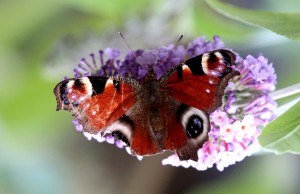 Recent publicity from “Butterfly Conservation – Scotland” has suggested that the hot summer of 2013 has helped butterflies bounce back after the disaster of last summer. There were even records of two migrant butterflies, the painted lady and the clouded yellow, being seen and the comma butterfly has been seen further north than before. This is all very well but in the Highlands this has been far from the case. Many readers have reported their worse year for butterflies for some years. Even “hot spots” such as the sand dunes east of Nairn failed to come up to their usual reputation. Many people noted a sharp decrease in the actual numbers of garden species with some of the usual ones not present at all. There has been a short respite in September when the sunshine brought out peacocks and red admirals and there are small numbers on Buddleias and Sedums in the garden as I write. However, small tortoiseshell butterflies have been few and far between and to think this used to be the commonest garden butterfly and in parts of the countryside.
Recent publicity from “Butterfly Conservation – Scotland” has suggested that the hot summer of 2013 has helped butterflies bounce back after the disaster of last summer. There were even records of two migrant butterflies, the painted lady and the clouded yellow, being seen and the comma butterfly has been seen further north than before. This is all very well but in the Highlands this has been far from the case. Many readers have reported their worse year for butterflies for some years. Even “hot spots” such as the sand dunes east of Nairn failed to come up to their usual reputation. Many people noted a sharp decrease in the actual numbers of garden species with some of the usual ones not present at all. There has been a short respite in September when the sunshine brought out peacocks and red admirals and there are small numbers on Buddleias and Sedums in the garden as I write. However, small tortoiseshell butterflies have been few and far between and to think this used to be the commonest garden butterfly and in parts of the countryside.
One of the problems is that to a certain extent we have become complacent about butterflies. There have been success stories such as the spread of such butterflies as orange tips, speckled wood and ringlets. There is some evidence, as has been happening down south, that some red admirals can now survive the winter, even in the Highlands. Then there was the remarkable invasion of painted ladies in 2003 when this very attractive butterfly just seemed everywhere and in large numbers. The immigration of painted ladies that year must have been one of the most outstanding butterfly phenomena for very many years. However, there was another quite spectacular event that is often overlooked and that is the history of the peacock butterfly in the Highlands and the event of September 2002.
Prior to that 2002 the peacock was always classed as a vagrant butterfly in the Highlands as only occasional records were made in various places in the north. There was no evidence of this butterfly over-wintering here. Then in September 2002 there was a remarkable invasion of peacocks and they flooded into eastern Inverness-shire and Moray. Their origin is still a mystery, although the weather pattern for that period could indicate they were from southern Scandinavia. Whatever their source there was great excitement for butterfly enthusiasts as the butterflies stayed, successfully over-wintered, and their descendants are still with us today.
Peacock butterflies are remarkable in a number of ways ever since it’s original name of “Peacock’s Eye”. It was also nick-named the “Owl” and the reason for this can be seen if you rotate the illustration and view the adult upside own. Without stretching the imagination it really does resemble the image of an owl! The butterfly also has its own defence mechanism against predators such as small birds and even small mammals such as mice. To start with if disturbed the flashing eye spots on the wings can be intimidating. Close to, particularly if there is a group of the butterflies, they rub their wings together and then there is not only a distinct rustling noise but also a hissing noise from their wings. Small birds and mice have been seen to back off when faced with this. Another defence is if a predator goes for one of the eyes on the wing as this is not a disaster. The photograph I took last week may indicate such a gap in the wing.
Tags: highland wildlife
